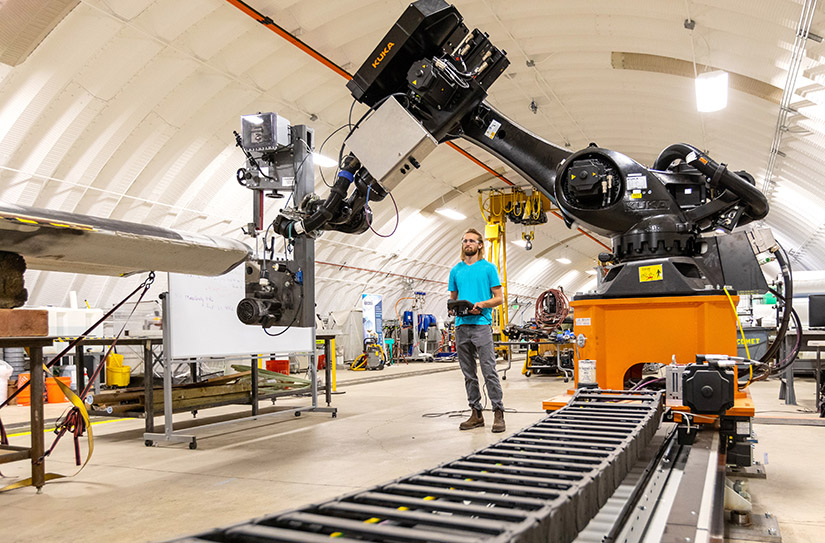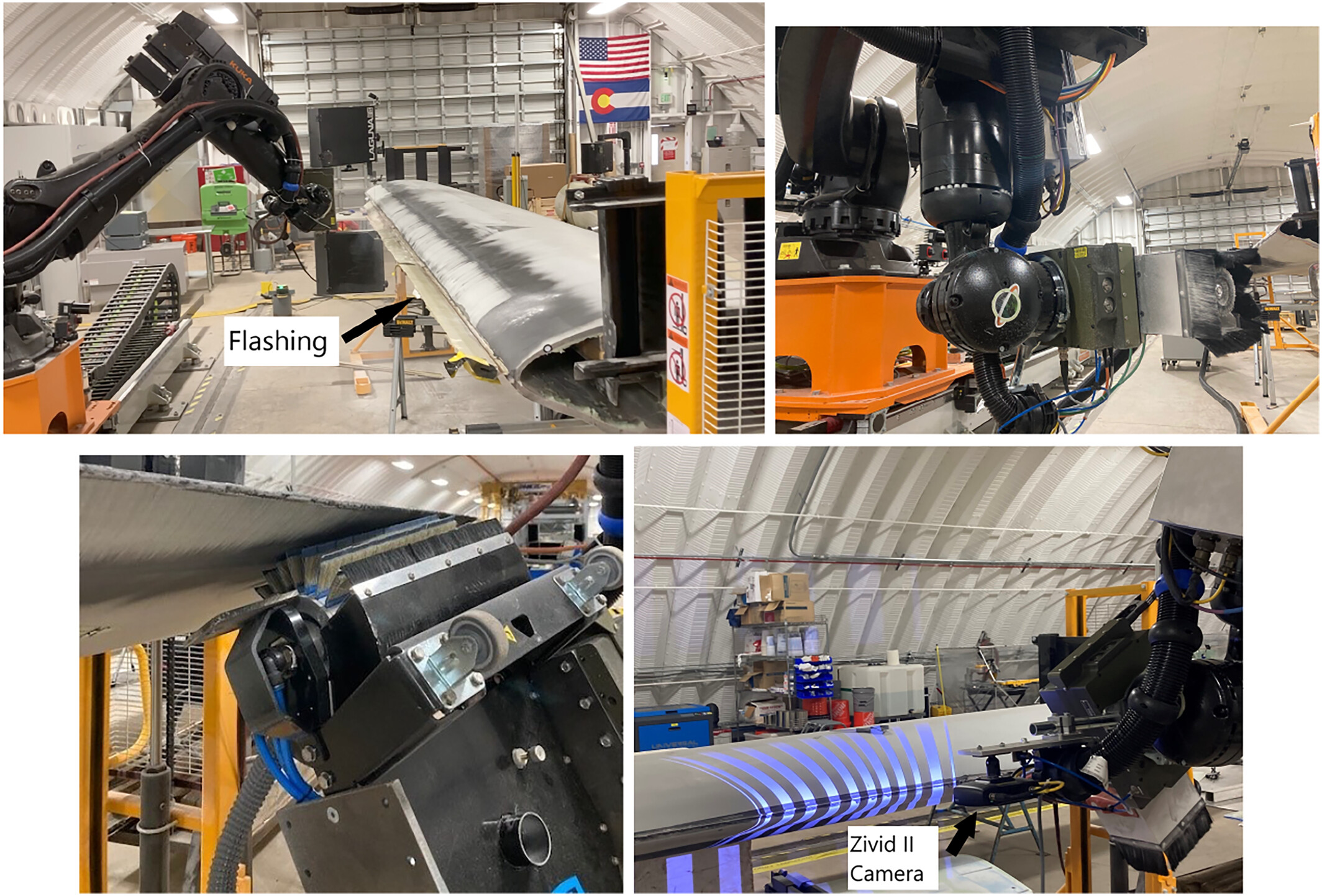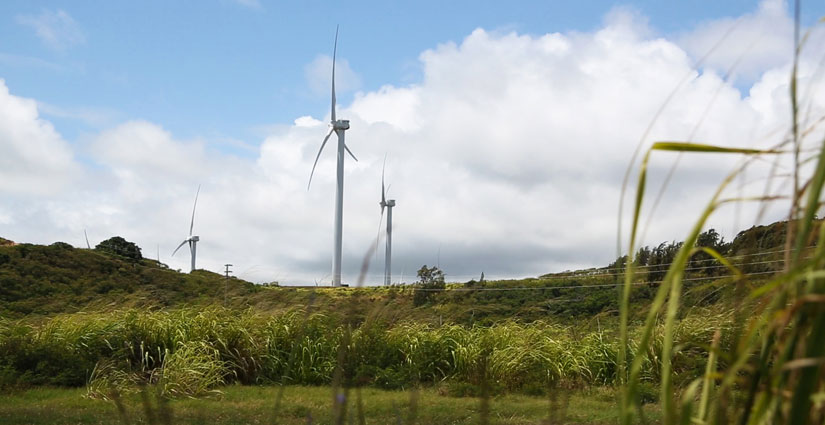Researchers Develop Automated System for Wind Turbine Blade Manufacturing
NREL researchers have brought robotics to post-molding operations in wind turbine blade manufacturing with a degree of success, sparking hope for automation and U.S.-based manufacturing in the wind energy industry.
Researchers from the U.S. Department of Energy’s National Renewable Energy Laboratory (NREL) have programmed an industrial robot to trim, grind, and sand wind turbine blades after molding operations. The researchers sought to refine the process, observing areas for further improvement while promoting the automated system’s long-term benefits of increased product quality and worker safety. The study’s findings were published in the journal Wind Energy.

NREL robotics engineer and lead author of the study, Hunter Huth, stands beside the robot programmed to automate part of the wind turbine manufacturing process. Image used courtesy of Werner Slocum, NREL
Operational Hazards in Finishing Operations
Wind turbine post-molding operations have potential physical, chemical, and ergonomic hazards. Wind turbine blade cutting and trimming require the use of instruments that can result in serious harm if not wielded with due care and attention. High-speed projectiles and acute edges are produced during drilling and grinding, which raises the possibility of cuts and puncture wounds. When handled manually, the big, heavy blades can crush someone, especially if the right tools or skills aren't used. Additional hazards arise from falling objects, such as tools or components.
Respiratory problems and skin irritation can result from breathing in hazardous fumes released by resins and adhesives used in composite materials. Fine dust produced by sanding, cutting, and grinding can also lead to respiratory issues, including silicosis. Additionally, chemical burns, dermal irritation, and respiratory risks arise from using chemicals in cleaning and finishing processes.

Kuka robot trimming, grinding, and sanding 5-meter long wind blade segments. Image used courtesy of NREL
Automating Wind Turbine Blade Manufacturing
Automating the finishing process of turbine blade manufacturing can provide a safe and more cost-effective alternative to human workers. Robots do not tire like humans, allowing them to work consistently, which improves product throughput. Robots can also take on repetitive and heavy-duty tasks, relieving burdens and freeing up human workers to pursue more high-value tasks.
The NREL research focused on developing automated procedures for the finishing process of turbine blades to make domestic offshore manufacturing more cost-competitive. At the Composites Manufacturing Education and Technology (CoMET) facility at NREL's Flatirons Campus, a KUKA KR 300 R2500 robot was programmed to operate on a 5-meter blade segment. The robot was programmed to work on segments of a wind turbine blade since complete blades bow under their weight.
By precisely defining the front and rear segments of the airfoil, researchers generated a 3D model of the turbine blade using scan data. After programming the robot to complete tasks, they assessed its speed and accuracy. They discovered that the robot's grinding was uneven, taking out too much or insufficient material, depending on the situation.
The researchers think that the system’s effectiveness has been held to increasingly higher standards by the research. Although robot and human performance were not compared, the team believes that automation provides constant quality and the capacity to apply harsher abrasives than humans can handle.

The NREL research aims to boost blade manufacturing in the U.S. and hopefully open up more jobs in the wind energy industry. Image used courtesy of NREL
The Wind Energy Industry Landscape
The 2023 Land-Based Wind Market Report shows that, in the U.S., wind power grew by 8.5 GW in 2022, rising to 144 GW in cumulative wind capacity by the end of the year. The growth in wind power (along with other renewable energy sources such as solar, wave and tidal, geothermal, and biomass) stems from the production tax credit (PTC) federal incentive. PTC is a ten-year tax credit that provides up to 2.75 cents per kWh for electricity produced from wind, geothermal, or closed-loop biomass resources.
The 2023 report highlighted that while the number of U.S.-manufactured nacelles and wind turbine towers has remained stable for several years, blade manufacturing fell in 2022. In 2022, 125,580 full-time jobs were employed in the wind industry in the U.S., despite many turbine manufacturers experiencing diminishing or even unfavorable profit margins. The enactment of the Inflation Reduction Act is expected to address supply-chain challenges domestically and facilitate industry growth. As of late, the U.S. land-based wind industry has seen the announcement of not less than eleven new, reopened, or enlarged production sites, adding over 3,000 new jobs.

 Facebook
Facebook Google
Google GitHub
GitHub Linkedin
Linkedin








